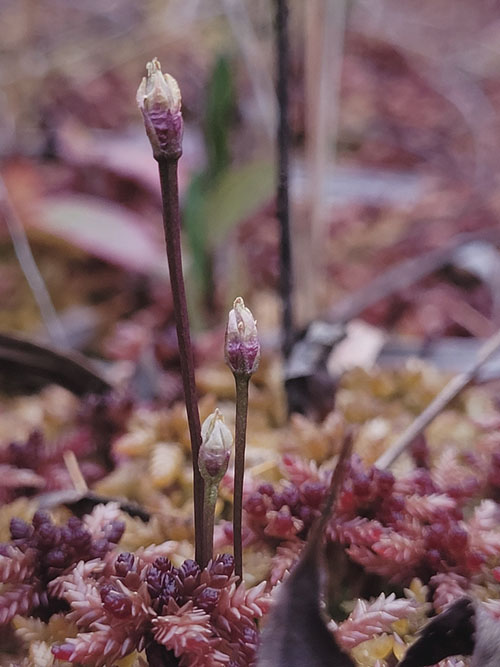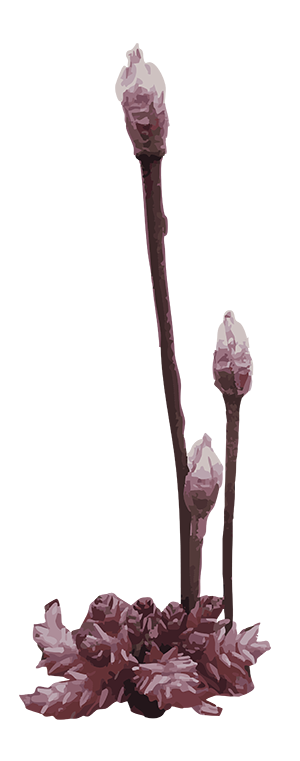Branched Bartonia

Species information
The following is a report on progress made towards the protection and recovery of Branched Bartonia (Bartonia paniculata) in Ontario from 2007 to 2023, based on Ontario’s species-specific recovery policy. This report meets the legislative requirement for a review of progress under the Endangered Species Act, 2007 (ESA or “the Act”). Branched Bartonia is listed as threatened on the Species at Risk in Ontario (SARO) List under the ESA.
Branched Bartonia has been classified as a species at risk since April 2004. It was originally classified as a threatened species and was listed as such under the ESA when it came into force in June 2008.
Branched Bartonia has been protected from being killed, harmed, harassed, captured or taken since 2008.
In addition, the habitat of Branched Bartonia has been protected from being damaged or destroyed since 2013.
The species-specific recovery policy for Branched Bartonia, known as the government response statement (GRS) was published in 2019 and includes the government’s recovery goal for the species and the actions and priorities it intends to lead or support to help achieve that goal. The GRS considers science advice provided in the recovery strategy (published in 2018), regarding things such as the species biology, habitat needs, threats to survival, knowledge gaps and approaches to recovery, when developing recovery actions for the species. As legislated in the Act, the purpose of this review is to report on progress made towards implementing the protection and recovery actions in the GRS. The review can also help identify opportunities to adjust and adapt the implementation of protection and recovery actions to achieve the recovery goal for the species.
Further information about Branched Bartonia, including the threats that it faces and actions being taken to help protect and recover this species, is available on the Government of Ontario webpage for Branched Bartonia. A summary on the progress towards the protection and recovery of Branched Bartonia and an annual update on the broader species at risk program (i.e. the Introduction to the 2024 Review of Progress report) is available on the Review of Progress towards the Protection and Recovery of Ontario’s Species at Risk webpage.
Snapshot: Progress towards the protection and recovery of Branched Bartonia
Progress towards meeting the recovery goal
- The recovery goal in the government response statement (GRS) for Branched Bartonia in Ontario is to “maintain the current distribution and support the viability of existing populations across Ontario”.
- Progress has been made towards implementing the majority of the government-led actions. Progress has been made towards implementing one of the government-supported recovery objectives and two of the associated actions. Examples of progress include:
- developing a standardized monitoring protocol for Branched Bartonia
- monitoring Branched Bartonia demographics and associated reproductive biology (i.e., pollination and seed production)
- conducting presence surveys for Branched Bartonia in peatlands where it has not been previously documented
- In alignment with the GRS, further work is required to:
- collaborate with partners and other jurisdictions to increase understanding of Branched Bartonia’s ecological needs, population viability and the factors that affect it
- assess the feasibility of potential control measures to manage the threat of Glossy Buckthorn or Common Reed at locations where they pose a threat to Branched Bartonia, develop guidance on best practices and implement them where possible without excessive damage of Branched Bartonia habitat
- maintain or enhance habitat suitability within or adjacent to areas currently occupied by Branched Bartonia in collaboration with landowners or land manager
Occurrences and distribution
- Thirteen populations
footnote 1 of Branched Bartonia have been documented in and around the Muskoka and Parry Sound regions of Central Ontario. Currently, all of these populations are considered extantfootnote 2 . At least five populations of Branched Bartonia have been newly-identified since 2008.
Government-supported stewardship projects
- Through the Species at Risk Stewardship Program, the Government of Ontario has enabled its stewardship partners to conduct two projects (by providing $32,131 in funding) that have supported the protection and recovery of Branched Bartonia.
- The government’s support helped its stewardship partners to involve two individuals who volunteered two hours of their time towards protection and recovery activities for Branched Bartonia. The estimated value of these voluntary contributions, as well as additional funding and in-kind support, is $2,833.
- Stewardship partners reported providing outreach on Branched Bartonia to six individuals.
Supporting human activities while ensuring appropriate support for species recovery
- The Government of Ontario has issued no permits for this species.
- No agreements were entered into for Branched Bartonia.
- Four activities have been undertaken in accordance with a conditional exemption that requires registration under the ESA. The activities followed the conditional exemption for ‘threats to health and safety, not imminent’ (section 23.18) under Ontario Regulation 242/08 of the ESA.
Reporting on the progress towards the protection and recovery of Branched Bartonia
Recovery goal
The government’s goal for the recovery of Branched Bartonia is to maintain the current distribution and support the viability of existing populations across Ontario.
The implementation of government-led and government-supported actions demonstrates progress towards reaching the desired objectives and the recovery goal set out in the GRS.
Progress towards implementing government-led actions
Progress has been made towards implementing the majority of government-led actions identified in the GRS. Common actions for the government to lead as it works towards achieving a species’ recovery goal include:
- Continue to implement the Ontario Invasive Species Strategic Plan (2012) to address the invasive species (e.g., Glossy Buckthorn, Phragmites) that threaten Branched Bartonia.
- Continue to implement Ontario’s Invasive Species Act to control the spread of invasive species that threaten Branched Bartonia by restricting the importation, deposition, release, breeding/ growing, buying, selling, leasing or trading of Phragmites.
- Educate other agencies and authorities involved in planning and environmental assessment processes on the protection requirements under the ESA.
- Encourage the submission of Branched Bartonia data to the Ontario’s central repository through the citizen science project that they receive data from (i.e., iNaturalist.ca) and directly through the Natural Heritage Information Centre.
- Undertake communications and outreach to increase public awareness of species at risk in Ontario.
- Continue to protect Branched Bartonia and its habitat through the ESA.
- Support conservation, agency, municipal and industry partners, and Indigenous communities and organizations to undertake activities to protect and recover Branched Bartonia. Support will be provided where appropriate through funding, agreements, permits (including conditions) and/or advisory services.
- Encourage collaboration, and establish and communicate annual priority actions for government support in order to reduce duplication of efforts.
- Conduct a review of progress toward the protection and recovery of Branched Bartonia within five years of the publication of this document.
Additionally, the government has directly undertaken the following species-specific actions:
- continue to monitor Branched Bartonia and manage its habitat in provincial parks and protected areas
Ministry of Natural Resources biologists monitored the population of Branched Bartonia at Jevins and Silver Lake Conservation Reserve during 2010, and the population at Loon Lake Bog Conservation Reserve during 2023.
Key progress made towards implementing these actions is described in the following sections.
Invasive species in Ontario
The Government of Ontario is committed to continuing its efforts to prevent, detect, respond to and manage invasive species in order to reduce their harmful impacts in the province, including to species at risk and their habitats. The GRS for Branched Bartonia indicates that invasive plant species (e.g., Glossy Buckthorn (Frangula alnus) and European Common Reed, also know as invasive Phragmites (Phragmites australis ssp. australis) pose a threat to the survival and recovery of Branched Bartonia in Ontario through competition and their effects on habitat).
To prevent the further spread and introduction of invasive Phragmites, it was listed as a restricted species under the Invasive Species Act in 2016. It is now illegal to import, deposit, release, breed/grow, buy, sell, lease or trade this restricted invasive species in Ontario. It is also illegal to bring a restricted species into a provincial park or conservation reserve and to possess, transport, deposit or release them in these protected areas.
Through collaborative efforts with our partners to identify innovative solutions to control invasive Phragmites, Ontario continues to take action to advance the management of this invasive plant. For example, the Ministry of Natural Resources (MNR) provided funding to support the development of A Strategic Framework for Coordinated Management of Invasive Phragmites in Ontario by the Green Shovels Collaborative, and is currently providing funding to support a newly established Invasive Phragmites Control Fund. Notably, this includes a recent (2024) investment of $16 million in grant funding over three years to be administered by the Invasive Species Centre and the Nature Conservancy of Canada, the majority of which is specifically dedicated to enabling community-led action on invasive Phragmites. MNR is also investigating potential biological control agents for invasive Phragmites with federal partners, the University of Toronto, and Ducks Unlimited Canada.
Occurrences and distribution
Tracking the occurrences and distribution of a species is a useful way to monitor and view where a species is found and how it is doing. Ontario’s Natural Heritage Information Centre (NHIC), the government’s central data repository, gathers and manages this type of biodiversity information. NHIC tracks and maps this data as species observations and individual element occurrences, where an element occurrence is an area of land and/or water where a species or plant community is or was present, and has a practical conservation value. For the purposes of this report, ‘population’ is an alternative name for element occurrence.
Thirteen populations of Branched Bartonia have been documented in Ontario. All are considered to be extant. However, there is evidence that one of the 13 populations may be extirpated given the failure to detect any plants during recent surveys, the small number of plants documented over the last 23 years and decreases in habitat area. Additionally, there have been occurrences reported at two locations in 2023 which may represent previously undocumented populations. All populations are located in Central Ontario, east of the southern end of Georgian Bay. Since 2008, the government’s central conservation data repository at the NHIC has received 33 records of the species, resulting in at least five newly-identified populations of this species in Ontario. These records are based on observations between 2007 and 2023 and come from a variety of sources. Records submitted have helped to refine where the species is known and has been known to occur and have provided additional information on the species’ habitat and threats. There have been at least three previously undocumented populations that have been discovered during 2022 or 2023.
The newly identified populations are likely the result of increased search effort and education about Branched Bartonia and likely do not represent actual population increases, but rather increased knowledge about the distribution of the species.
It is possible that there are observations of Branched Bartonia that have not been submitted to the government. Encouraging the submission of observations of this species is included in the GRS as a government-led action. Submission of species observations increases our knowledge of where they occur and can play an important role in assessing the viability of species populations.
Everyone is encouraged, or may be required by an authorization or condition of a regulatory exemption, to submit observations of Branched Bartonia, and any other species at risk observed, to the NHIC for incorporation into the provincial record of observations.
- 33observations of this species were submitted to the NHIC since 2008
Government-supported stewardship projects
An important government-led action in the GRS for Branched Bartonia is to support partners to undertake activities to protect and recover the species. Through the Species at Risk Stewardship Program the government has supported two projects ($32,131) designed to contribute to the protection and recovery of Branched Bartonia. These projects were focused exclusively on Branched Bartonia.
In addition to the government funding, partners focusing exclusively on Branched Bartonia reported they were successful in securing additional funding ($2,833) from other sources. These amounts include in-kind support in the form of time and expertise provided by volunteers.
Stewardship partners reported that provincial funding helped them to secure in-kind support by involving two individuals who volunteered two hours of their time towards protection and recovery activities that focused exclusively on Branched Bartonia, which has an estimated value of $100. In addition, stewardship partners reported providing focused outreach on Branched Bartonia to six individuals.
The remainder of this section highlights a project supported through the Species at Risk Stewardship Program as well as the corresponding government-supported recovery actions for the species.
The objective of the project was to develop a survey and monitoring protocol for Branched Bartonia, and to apply it at most locations where Branched Bartonia populations have been documented in Ontario in addition to several locations where conditions are suitable to support populations of Branched Bartonia. The project was undertaken by the Cambridge-based ecological consulting company, North-South Environmental Inc., with support from the Oshawa-based company, Blazing Star Environmental. It was a two-year project commencing in early 2022. Field surveys were initiated during the late summer of that year and continued during the late summer of 2023. Bog and fen vegetation communities in the southern Georgian Bay region were surveyed for Branched Bartonia populations. A total of 30 locations were visited, 10 of which had previously documented populations of Branched Bartonia. Branched Bartonia was located at 13 of the surveyed locations.
In addition to estimating population size, North-South Environmental Inc. completed an ecological land classification and rapid botanical inventory at all locations where plants of Branched Bartonia were found. North-South Environmental Inc. also conducted a pollinator study at 11 locations, documenting no insect pollinators of Branched Bartonia during either year of the study. Numbers of flowers and seed pods were enumerated at some locations to study fruit set. At least one, and possibly three, previously unrecorded subpopulations of Branched Bartonia were documented during the project.
A survey and monitoring protocol was drafted during 2022 on the basis of a literature review and experience monitoring Branched Bartonia populations possessed by Ontario biologists, including those at North-South Environmental Inc. The protocol was finalized in 2023 based on the additional experience gained from the project.
The project contributed to the government-supported actions to develop and implement a standardized survey and monitoring protocol for Branched Bartonia and to conduct presence surveys in peatlands where Branched Bartonia has not been documented.
 2
2project for Branched Bartonia exclusively
 $32,131
$32,131for Branched Bartonia exclusively
 $2,833
$2,833in additional funding and in-kind support
 2
2volunteers
 2
2volunteer hours
 6
6people received outreach
Supporting human activities while ensuring appropriate support for species recovery
Supporting partners through authorizations and their associated conditions is an important government-led action. To date, no permits have been issued for Branched Bartonia.
Four activities that may affect Branched Bartonia or its habitat have been registered for the purposes of Ontario Regulation 242/08: ‘General’ under the ESA. All activities were registered under ‘threats to human health and safety, not imminent’ (section 23.18). These registrations require the registrant to comply with all conditions of the regulation, such as:
- before commencing the activity, giving the Minister notice of the activity by submitting a notice of activity form available on the Registry to the Minister through the Registry
- while carrying out the activity, taking reasonable steps to minimize the adverse effects of the activity on any species identified in the notice of activity form
- if it is necessary to kill or harm a plant for the purpose of carrying out the activity, relocating the plant to a nearby location within the species’ habitat that is suitable and safe for the species so that it is not killed or harmed, provided it is feasible to do so
- 4registrations
Progress towards implementing government-supported actions
Government-supported actions are organized under overarching recovery objectives. Progress has been made towards achieving one government-supported recovery objective and implementing two of the associated actions identified in the GRS for Branched Bartonia.
Objective: Increase knowledge of Branched Bartonia populations, biology and ecology:
- Action No. 1 (High Priority) – Develop and implement a standardized monitoring protocol and program for Branched Bartonia. The program should be designed and implemented in such a manner that it minimizes impacts on the species and its habitat, and such that it may contribute to research actions. The program should aim to:
- monitor population trends, demographics and associated reproductive biology (e.g., pollination, seed production and germination rates)
- monitor associated habitat and conditions (e.g., percentage of canopy cover, hydrology)
- monitor and document threats to the species, including the presence of invasive species (e.g., Glossy Buckthorn and European Reed)
- Action No. 4 – Conduct presence-absence surveys for Branched Bartonia in additional Central Ontario peatlands.
Under this objective, progress has been made towards implementing Action No. 1, while initial progress has been made towards Action No. 4.
The first action has been implemented through the aforementioned project supported by the Species at Risk Stewardship Program. The second action has been implemented through this project and a second project that consisted of presence surveys for Branched Bartonia in the County of Haliburton, where no populations were detected.
Summary of progress towards meeting the recovery goal
The recovery goal for Branched Bartonia is “to maintain the current distribution and support the viability of existing populations across Ontario”. Effort made towards the government-led and government-supported actions has helped to make progress towards this goal. For example, the North-South Environmental Inc. monitoring project, supported by the Species at Risk Stewardship Program, has provided updated information on populations of Branched Bartonia and the distribution of the species in Central Ontario.
Recommendations
As stated in the GRS, this review of progress can be used to help identify whether adjustments to the implementation of GRS actions are needed, to achieve the protection and recovery of the species. Based on progress to date, the overall direction provided in the GRS for Branched Bartonia, particularly the implementation of actions identified as high priority, should continue to guide protection and recovery of the species.
Although progress has been made towards the action to develop and implement a standardized monitoring protocol and program for Branched Bartonia, further work is required to fully implement Branched Bartonia monitoring. Similarly, although presence surveys have been completed in Central Ontario peatlands where Branched Bartonia has not been detected and previously undocumented populations have been discovered in some of them, more work is required to develop presence-absence survey standards to confirm absence in the others.
More generally, progress would be advanced by the completion of high priority actions related to population viability research and collaborative stewardship to evaluate and, where feasible, implement control measures against invasive plant threats in Ontario.
Protecting and recovering Branched Bartonia will continue to be a shared responsibility that will require the involvement of many individuals, organizations and communities. Financial support for the implementation of actions may be available through the Species at Risk Stewardship Program. The government can also advise if any authorizations under the ESA or other legislation may be required to undertake a project. By working together, progress can continue to be made towards protecting and recovering Branched Bartonia in Ontario.
Footnotes
- footnote[1] Back to paragraph For the purposes of this report, a ’population’ is used as an alternative name for an ‘element occurrence’, which is defined as an area of land and/or water on/in which an element (e.g., a species) is or was present. A population record is based on one or more observations and the area has a practical conservation value as it is important to the conservation of the species.
- footnote[2] Back to paragraph A population is considered extant if it has been observed within the last 20 years or an appropriate interval for the species in question. Extant populations may have been extirpated, particularly if observations are not recent and updated information is unavailable.